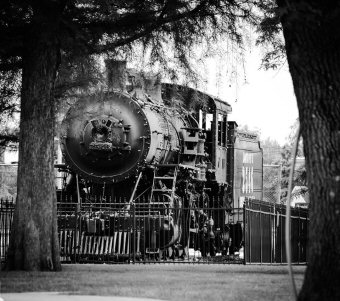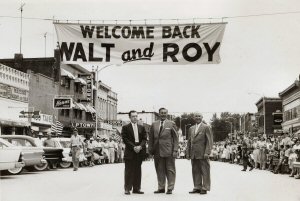Our History!

Closely identified with the story of the great expansive movement of the Santa
Fe Railroad in the 1880's and 1890's is the history of Marceline, located in the
southeast corner of Linn County, Missouri. The Santa Fe was the first railroad
to establish a road linking Chicago and Kansas City, and Kansas City, Kansas
linking Chicago to the west coast along a one-company line. To plan the new
line, the railroad engineers, for the most part, drew on a map a straight line
between Chicago and Kansas City. Corporate decisions, based on technological
needs, created towns along the new lines at regular intervals so the locomotives
could take on water, fuel, and a crew change.
Towns sprung up: Rutledge, Standish, Gibbs, Wyaconda, Cardy, Bosworth and
Marceline, headquarters for the Santa Fe's Missouri Division.
Marceline received its name at the request of one of the directors of the new
railroad, whose wife bore the somewhat Spanish name of "Marcelina". So with a
change of the last vowel, this became the name of the new railroad city.
On March 6th, 1888 an election was held and the Linn County Court incorporated
the City of Marceline based on the results of the election. At that time A.D.
Reynolds was appointed as mayor, the aldermen appointed were J.H. Perrin, W.S.
Thomas, George LeVan and J.E. Dorsey. They served until the first city election
was held. Their first official act was to establish wards in the City, passing
by ordinance the day after they were appointed. The town's officials established
the office of City Marshal, City Street Commissioner and City Clerk.
By mid-summer 1888, several businesses were flourishing, churches were built and
plans were underway for the first term of school in the fall. Mining of the
area's substantial deposits of coal had already begun to fuel the coal-burning
locomotives of the Santa Fe. Captain U.C. Wheelock sank the first coal shaft
for the Marceline Coal and Mining Company and others.
In Marceline's first quarter century, the City went through growing pains that
many new towns of America's West experienced. With the passing of the boom days
and the additional developments and stabilization of its railroad offices, the
businesses of the City took on a more permanent and conservative air.
 In
the spring of 1906, Elias and Flora Disney moved their family from Chicago IL to
Marceline MO. Their youngest son named Walter would experience all of his
childhood firsts in Marceline. Walt attended his first school, saw his first
motion picture, caught his first fish, and saw “Peter Pan”, his first live stage
performance. Walter Disney’s memories of Marceline would stay with him
throughout his life and serve as his inspiration for great things to come.
In
the spring of 1906, Elias and Flora Disney moved their family from Chicago IL to
Marceline MO. Their youngest son named Walter would experience all of his
childhood firsts in Marceline. Walt attended his first school, saw his first
motion picture, caught his first fish, and saw “Peter Pan”, his first live stage
performance. Walter Disney’s memories of Marceline would stay with him
throughout his life and serve as his inspiration for great things to come.
Walt Disney returned to Marceline in 1946 to take photos of the farm, Main
Street (Kansas Avenue), Park School and the Santa Fe Station, whereas, in 1955,
he opened Disneyland, whose Main Street USA is inspired by Kansas Avenue. At
that time, Walt released the movie “Lady and the Tramp”, which harkens back to
Walt’s time in Marceline.
During the late 1940's and the 1950's, Marceline grew into an industrial center
for North Central Missouri. It is particularly noted for its printing and
publishing industry.
In 1956, Walt Disney returned to Marceline to attend
the dedication of the Walt Disney Swimming Pool and the park. He held the
Midwest premiere of the Disney feature film “The Great Locomotive Chase” at the
Uptown Theatre. Walt attended the Walt Disney Elementary School dedication
ceremony and donated playground equipment, unique murals, educational films and
audio-visual equipment.
An important development in municipal government was the change from a
Mayor-Council form of government to now, a Third Class City, Council-Manager
form of government. In June 1953, the city's first manager was appointed. One of
the smallest cities in the state with a City Manager, Marceline has been run by
a professional manager ever since.
